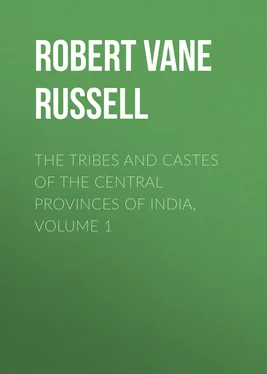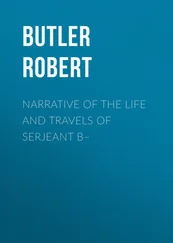Robert Vane Russell - The Tribes and Castes of the Central Provinces of India, Volume 1
Здесь есть возможность читать онлайн «Robert Vane Russell - The Tribes and Castes of the Central Provinces of India, Volume 1» — ознакомительный отрывок электронной книги совершенно бесплатно, а после прочтения отрывка купить полную версию. В некоторых случаях можно слушать аудио, скачать через торрент в формате fb2 и присутствует краткое содержание. Жанр: foreign_prose, История, foreign_edu, foreign_antique, на английском языке. Описание произведения, (предисловие) а так же отзывы посетителей доступны на портале библиотеки ЛибКат.
- Название:The Tribes and Castes of the Central Provinces of India, Volume 1
- Автор:
- Жанр:
- Год:неизвестен
- ISBN:нет данных
- Рейтинг книги:5 / 5. Голосов: 1
-
Избранное:Добавить в избранное
- Отзывы:
-
Ваша оценка:
- 100
- 1
- 2
- 3
- 4
- 5
The Tribes and Castes of the Central Provinces of India, Volume 1: краткое содержание, описание и аннотация
Предлагаем к чтению аннотацию, описание, краткое содержание или предисловие (зависит от того, что написал сам автор книги «The Tribes and Castes of the Central Provinces of India, Volume 1»). Если вы не нашли необходимую информацию о книге — напишите в комментариях, мы постараемся отыскать её.
The Tribes and Castes of the Central Provinces of India, Volume 1 — читать онлайн ознакомительный отрывок
Ниже представлен текст книги, разбитый по страницам. Система сохранения места последней прочитанной страницы, позволяет с удобством читать онлайн бесплатно книгу «The Tribes and Castes of the Central Provinces of India, Volume 1», без необходимости каждый раз заново искать на чём Вы остановились. Поставьте закладку, и сможете в любой момент перейти на страницу, на которой закончили чтение.
Интервал:
Закладка:
In a list of classes or occupations given in the White Yajur-Veda, and apparently referring to a comparatively advanced state of Hindu society, tillage is laid down as the calling of the Vaishya, and he is distinguished from the Vāni or merchant, whose occupation is trade or weighing. 38 38 List of classes of Indian society given in the Purusha-Medha of the White Yajur-Veda, Wilson, pp. 126–135.
Manu states that a Brāhman should swear by truth; a Kshatriya by his steed and his weapons; a Vaishya by his cows, his seed and his gold; and a Sūdra by all wicked deeds. 39 39 Manu, viii. 113.
Yellow is the colour of the Vaishya, and it must apparently be taken from the yellow corn, and the yellow colour of ghī or butter, the principal product of the sacred cow; yellow is also the colour of the sacred metal gold, but there can scarcely have been sufficient gold in the hands of the body of the people in those early times to enable it to be especially associated with them. The Vaishyas were thus, as is shown by the above evidence, the main body of the people referred to in the Vedic hymns. When these settled down into villages the Vaishyas became the householders and cultivators, among whom the village lands were divided; the Sūdras or indigenous tribes, who also lived in the villages or in hamlets adjoining them, were labourers and given all the most disagreeable tasks in the village community, as is the case with the impure castes at present.
14. Mistaken modern idea of the Vaishyas
The demonstration of the real position of the Vaishyas is important, because the Hindus themselves no longer recognise this. The name Vaishya is now frequently restricted to the Bania caste of bankers, shopkeepers and moneylenders, and hence the Banias are often supposed to be the descendants and only modern representatives of the original Vaishyas. Evidence has been given in the article on Bania to show that the existing Bania caste is mainly derived from the Rājpūts. The name Bāni, a merchant or trader, is found at an early period, but whether it denoted a regular Bania caste may be considered as uncertain. In any case it seems clear that this comparatively small caste, chiefly coming from Rājputāna, cannot represent the Vaishyas, who were the main body or people of the invading Aryans. At that time the Vaishyas cannot possibly have been traders, because they alone provided the means of subsistence of the community, and if they produced nothing, there could be no material for trade. The Vaishyas must, therefore, as already seen, have been shepherds and cultivators, since in early times wealth consisted almost solely of corn and cattle. At a later period, with the increased religious veneration for all kinds of life, agriculture apparently fell into some kind of disrepute as involving the sacrifice of insect life, and there was a tendency to emphasise trade as the Vaishya’s occupation in view of its greater respectability. It is considered very derogatory for a Brāhman or Rājpūt to touch the plough with his own hands, and the act has hitherto involved a loss of status: these castes, however, did not object to hold land, but, on the contrary, ardently desired to do so like all other Hindus. Ploughing was probably despised as a form of manual labour, and hence an undignified action for a member of the aristocracy, just as a squire or gentleman farmer in England might consider it beneath his dignity to drive the plough himself. No doubt also, as the fusion of races proceeded, and bodies of the indigenous tribes who were cultivators adopted Hinduism, the status of a cultivator sank to some extent, and his Vaishyan ancestry was forgotten. But though the Vaishya himself has practically disappeared, his status as a cultivator and member of the village community appears to remain in that of the modern cultivating castes, as will be shown subsequently.
15. Mixed unions of the four classes
The settlement of the Aryans in India was in villages and not in towns, and the Hindus have ever since remained a rural people. In 1911 less than a tenth of the population of India was urban, and nearly three-quarters of the total were directly supported by agriculture. Apparently, therefore, the basis or embryo of the gradation of Hindu society or the caste system should be sought in the village. Two main divisions of the village community may be recognised in the Vaishyas or cultivators and the Sūdras or impure serfs and labourers. The exact position held by the Kshatriyas and the constitution of their class are not quite clear, but there is no doubt that the Brāhmans and Kshatriyas formed the early aristocracy, ranking above the cultivators, and a few other castes have since attained to this position. From early times, as is shown by an ordinance of Manu, men of the higher castes or classes were permitted, after taking a woman of their own class for the first wife, to have second and subsequent wives from any of the classes beneath them. This custom appears to have been largely prevalent. No definite rule prescribed that the children of such unions should necessarily be illegitimate, and in many cases no doubt seems to exist that, if not they themselves, their descendants at any rate ultimately became full members of the caste of the first ancestor. According to Manu, if the child of a Brāhman by a Sūdra woman intermarried with Brāhmans and his descendants after him, their progeny in the seventh generation would become full Brāhmans; and the same was the case with the child of a Kshatriya or a Vaishya with a Sūdra woman. A commentator remarks that the descendants of a Brāhman by a Kshatriya woman could attain Brāhmanhood in the third generation, and those by a Vaishya woman in the fifth. 40 40 Hopkin’s and Burnett’s Code of Manu, x. 64, 65, and footnotes.
Such children also could inherit. According to the Mahābhārata, if a Brāhman had four wives of different castes, the son by a Brāhman wife took four shares, that by a Kshatriya wife three, by a Vaishya wife two, and by a Sūdra wife one share. 41 41 Mahābhārata, xiii. 2510 et. seq ., quoted by Wilson, p. 272.
Manu gives a slightly different distribution, but also permits to the son by a Sūdra wife a share of the inheritance. 42 42 Manu, ix. 149, 157.
Thus the fact is clear that the son of a Brāhman even by a Sūdra woman had a certain status of legitimacy in his father’s caste, as he could marry in it, and must therefore have been permitted to partake of the sacrificial food at marriage; 43 43 Manu indeed declares that such children could not be initiated (x. 68), but it is clear that they must, as a matter of fact, have been capable of initiation or they could not possibly have been married in the father’s caste.
and he could also inherit a small share of the property.
16. Hypergamy
The detailed rules prescribed for the status of legitimacy and inheritance show that recognised unions of this kind between men of a higher class and women of a lower one were at one time fairly frequent, though they were afterwards prohibited. And they must necessarily have led to much mixture of blood in the different castes. A trace of them seems to survive in the practice of hypergamy, still widely prevalent in northern India, by which men of the higher subcastes of a caste will take daughters in marriage from lower ones but will not give their daughters in return. This custom prevails largely among the higher castes of the Punjab, as the Rājpūts and Khatris, and among the Brāhmans of Bengal. 44 44 See article on Brāhman for some further details.
Only a few cases are found in the Central Provinces, among Brāhmans, Sunārs and other castes. Occasionally intermarriage between two castes takes place on a hypergamous basis; thus Rājpūts are said to take daughters from the highest clans of the cultivating caste of Dāngis. More commonly families of the lower subcastes or clans in the same caste consider the marriage of their daughters into a higher group a great honour and will give large sums of money for a bridegroom. Until quite recently a Rājpūt was bound to marry his daughters into a clan of equal or higher rank than his own, in order to maintain the position of his family. It is not easy to see why so much importance should be attached to the marriage of a daughter, since she passed into another clan and family, to whom her offspring would belong. On the other hand, a son might take a wife from a lower group without loss of status, though his children would be the future representatives of the family. Another point, possibly connected with hypergamy, is that a peculiar relation exists between a man and the family into which his daughter has married. Sometimes he will accept no food or even water in his son-in-law’s village. The word sāla , signifying wife’s brother, when addressed to a man, is also a common and extremely offensive term of abuse. The meaning is now perhaps supposed to be that one has violated the sister of the person spoken to, but this can hardly have been the original significance as sasur or father-in-law is also considered in a minor degree an opprobrious term of address.
Интервал:
Закладка:
Похожие книги на «The Tribes and Castes of the Central Provinces of India, Volume 1»
Представляем Вашему вниманию похожие книги на «The Tribes and Castes of the Central Provinces of India, Volume 1» списком для выбора. Мы отобрали схожую по названию и смыслу литературу в надежде предоставить читателям больше вариантов отыскать новые, интересные, ещё непрочитанные произведения.
Обсуждение, отзывы о книге «The Tribes and Castes of the Central Provinces of India, Volume 1» и просто собственные мнения читателей. Оставьте ваши комментарии, напишите, что Вы думаете о произведении, его смысле или главных героях. Укажите что конкретно понравилось, а что нет, и почему Вы так считаете.












